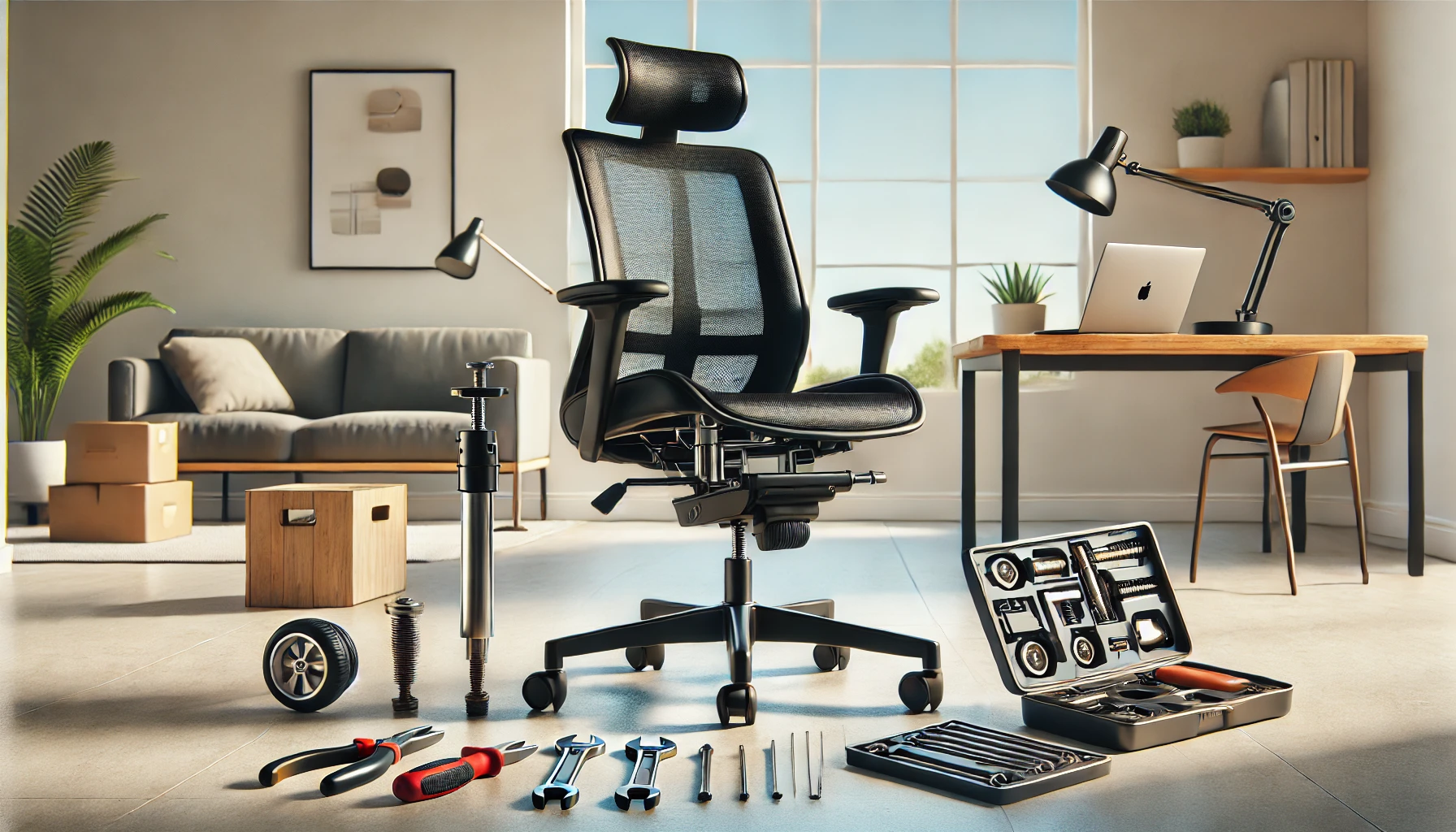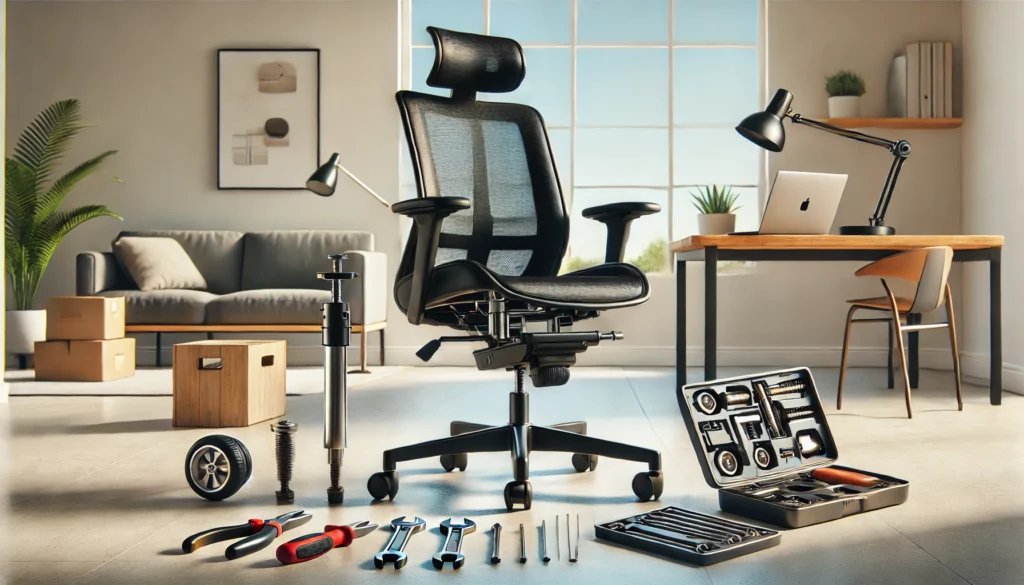How to Remove Office Chair Base – A Step-by-Step Guide

Understanding the Office Chair Base
An office chair base might seem like a simple part of your chair, but it plays a crucial role in stability, mobility, and comfort. To truly understand its importance, let’s break down its components, explore the common types, and identify when it might be time for a replacement.
Components of an Office Chair Base
The base of your office chair consists of several interconnected parts that work together to provide support and flexibility:
- Central Hub: The heart of the base where all the legs are connected. It also houses the gas cylinder that controls height adjustments.
- Legs (Spider Arms): Most bases feature five or more legs, ensuring stability and preventing tipping over.
- Casters (Wheels): These allow smooth movement across the floor. Casters can be made of plastic, rubber, or metal depending on the chair’s design.
- Gas Cylinder: A pneumatic mechanism that enables height adjustment by controlling air pressure.
- Base Plate: This connects the seat to the gas cylinder and helps with swiveling and tilting movements.
Each of these components plays a role in keeping your chair functional and comfortable. Ignoring even minor issues can lead to bigger problems, so keeping an eye on their condition is a smart move.
Common Types of Office Chair Bases
Not all office chair bases are created equal. Here are the most common types:
- Plastic Bases: Lightweight, affordable, and common in budget chairs, but less durable.
- Metal Bases: Made of aluminum or steel, these bases are sturdy, durable, and ideal for heavier users or extended use.
- Wooden Bases: Often found in executive or decorative chairs, these bases add an elegant touch but lack mobility.
- Chrome-Plated Bases: Stylish and durable, chrome bases combine aesthetics with functionality.
- Nylon Bases: A middle ground between plastic and metal, offering better strength than plastic without the weight of metal.
Choosing the right base depends on your needs. Whether it’s durability, design, or cost, understanding the options can make all the difference.
Signs Your Office Chair Base Needs Removal or Replacement
Is your chair base causing more headaches than comfort? Here are some telltale signs it’s time to take action:
- Wobbly Chair: A loose or unsteady base can be a red flag for potential breakage.
- Damaged Casters: Wheels that stick, squeak, or don’t roll smoothly can hinder mobility.
- Cracked or Broken Legs: Visible damage to the legs compromises the chair’s stability.
- Height Adjustment Issues: If your gas cylinder no longer adjusts or holds the height, it may need replacing.
- Rust or Wear: For metal bases, rust can weaken the structure, while excessive wear is a warning sign for all materials.
As the saying goes, “Don’t wait for the wheels to fall off!” Addressing these issues promptly can save you from costly repairs or even accidents.
Understanding your office chair base not only helps with maintenance but also ensures you get the most out of your chair. Whether you’re fixing it or upgrading, a little knowledge goes a long way in keeping things smooth and steady.
Preparation Before Removing the Office Chair Base
Before you start removing the office chair base, proper preparation is key to ensuring the task goes smoothly. Taking a few extra steps upfront can prevent frustration and help avoid potential damage to your chair. With the right safety measures in place, the process becomes much easier and more manageable. By organizing your workspace and gathering your tools in advance, you can stay focused and efficient. Preparation is essential to achieving a successful result.
Safety Precautions to Follow
Safety should always be your first priority when working with office furniture. Begin by clearing the area of any clutter to prevent tripping hazards or losing small parts like screws. Make sure the chair is on a flat, stable surface to avoid accidents during the removal process. Wearing gloves protects your hands from sharp edges or rough parts, while safety glasses guard against debris. Using lubricant on stuck parts will help loosen them without applying excessive force, which could cause damage.
Tools You’ll Need for the Job
Having the proper tools ready before you begin will make the task much easier. You will likely need a screwdriver to remove screws from the chair base or casters. A rubber mallet can be helpful for gently tapping components loose without damaging them. An adjustable wrench is useful for loosening bolts or nuts that may be tight. If parts are stuck due to rust, a lubricant like WD-40 can make the process smoother. Additionally, using a work mat or towel helps protect your floor and catch any falling components.

Methods to Remove the Office Chair Base
When it’s time to remove the office chair base, there are several methods to choose from, depending on the type of base and mechanism your chair uses. Each method requires a slightly different approach and set of tools. Below, we’ll explore three common methods for base removal: detaching the gas cylinder, removing the base with a cylinder clip, and disassembling the swivel base. By understanding the steps for each method, you’ll be able to tackle the job efficiently and safely.
Method 1: Detaching the Gas Cylinder Base
Required Tools
To detach the gas cylinder base, you’ll need a few key tools to get the job done. A flathead screwdriver or Phillips screwdriver will help with removing screws or securing the base. An adjustable wrench will be necessary for loosening bolts, while a rubber mallet is useful for gently tapping stubborn parts loose. If the gas cylinder is stuck, a lubricant spray like WD-40 can ease the process.
Steps to Remove the Gas Cylinder Base
To remove the gas cylinder base, start by flipping the chair upside down on a soft surface to prevent damage. Look for any screws that are holding the base in place, and use the appropriate screwdriver to remove them. Once the screws are out, use the adjustable wrench to loosen the bolts connecting the gas cylinder to the base. If the cylinder is stuck, apply some lubricant to the joint and tap it lightly with a rubber mallet. Gently pull the cylinder from the base, ensuring you don’t force it. This method is simple but requires patience to avoid damaging the components.
Method 2: Removing the Base with the Cylinder Clip
Required Tools
To remove the base with a cylinder clip, you’ll need a flathead screwdriver for prying the clip off, pliers to grip any pins or clips, and lubricant if the clip is resistant. A rubber mallet might also be necessary for loosening stuck components, and a wrench can help with any remaining bolts or screws.
Step-by-Step Instructions
Start by flipping the chair over to access the base mechanism. Look for the cylinder clip that secures the base to the chair frame. Using a flathead screwdriver, gently pry the clip off, being careful not to damage it. If the clip is difficult to remove, use pliers to grip and pull it free. Once the clip is removed, the base should detach easily from the cylinder. If it’s still stuck, lubricate the joint and tap it lightly with a rubber mallet to loosen any resistance. This method is ideal for chairs with clip-secured bases.
Method 3: Disassembling the Swivel Base
Tools Checklist
To disassemble the swivel base, make sure you have a Phillips screwdriver, adjustable wrench, rubber mallet, and lubricant spray. Depending on your chair’s design, you might also need pliers to remove pins or clips that secure the base to the frame.
How to Safely Disassemble
Begin by turning the chair upside down to access the base and swivel mechanism. Start by removing any screws or bolts that hold the swivel base in place. Use the adjustable wrench to loosen any tight bolts, and use the rubber mallet to gently tap away any stuck parts. Once the screws and bolts are removed, you may need to disassemble the swivel mechanism itself, which could involve removing pins or clips. Use pliers to carefully pull these free. If the base is still not coming off, apply some lubricant and allow it to sit for a few minutes before continuing. Disassembling the swivel base requires careful attention to detail to avoid damaging delicate parts.
Troubleshooting Common Challenges During Chair Base Removal
While removing your office chair base is often a straightforward task, it’s not uncommon to encounter some challenges along the way. From stuck gas cylinders to unexpected issues with other parts, troubleshooting these problems early on can save you time and frustration. Here, we’ll explore two of the most common challenges and provide effective solutions to help you complete the job with ease.
Stuck Gas Cylinder? Here’s What to Do
A stuck gas cylinder can be one of the most frustrating issues you’ll face when removing your office chair base. Over time, gas cylinders may become jammed due to pressure or rust, making it difficult to remove the base. If you encounter this problem, the first step is to apply a generous amount of lubricant spray (such as WD-40) to the joint where the cylinder meets the base. Let the lubricant sit for a few minutes to break down any rust or debris. If the cylinder is still stuck, use a rubber mallet to gently tap the base and loosen the connection. Be careful not to apply too much force, as this could damage the chair. If this method doesn’t work, you may need to use a pipe wrench or clamp to get a better grip and give the cylinder a firm twist to release it. Patience is key—sometimes all it takes is a little extra time and the right approach to get it loose.
Avoiding Damage to Your Office Chair Parts
When disassembling your office chair, it’s easy to accidentally damage the chair parts, especially if you’re using excessive force or the wrong tools. To avoid damaging components, always make sure you’re using the proper tools for each part of the chair. For example, a rubber mallet should be used for gently tapping parts loose, while a screwdriver or adjustable wrench is best for removing screws and bolts. If you encounter resistance, avoid using too much force, as this can strip screws, brake components, or cause parts to bend.
Always work slowly and methodically, checking the chair for any hidden screws or fasteners before proceeding. If a part is particularly stuck, try using lubricant to loosen it instead of forcing it. Lastly, be sure to keep all the components organized so you don’t lose any small pieces that could be vital to reassembling your chair. By taking care during the process, you’ll protect your chair and ensure that it functions properly after the base removal.
Replacing or Reinstalling the Office Chair Base
Whether you’re replacing a damaged office chair base or reinstalling a new one, it’s essential to follow the correct steps to ensure the process goes smoothly. Replacing the base can breathe new life into your chair, improving its functionality and comfort. In this section, we’ll guide you through how to choose a compatible replacement base and the steps involved in installing it properly.
How to Choose a Compatible Chair Base Replacement
When selecting a new base for your office chair, compatibility is key. First, determine the size and style of the base that fits your chair model. Most office chairs use a 5-star base with casters, but there can be variations in the size of the gas cylinder, the number of casters, or the style of the base. Make sure the replacement base matches the specifications of your current chair, particularly the gas cylinder size and the number of casters.
Check for weight capacity to ensure the base can support your body weight comfortably and safely. Some bases also come with additional features like adjustable height or a tilt mechanism—decide if these features are important to you. Always consult the manufacturer’s recommendations or the product manual to ensure a perfect fit and avoid any issues during installation.
Steps to Install a New Base
Once you have the replacement base, it’s time to install it. Start by flipping your chair upside down, ensuring the seat and back are protected from scratches by placing it on a soft surface. If there is a remaining gas cylinder or old base, carefully remove it by following the steps in the previous sections.
Once the chair is clear, align the new base with the bottom of the chair, ensuring that the gas cylinder fits securely into its designated slot. Tighten any screws or bolts that hold the base in place using an adjustable wrench or screwdriver. If the base includes casters, ensure they are properly attached to the base, as these will help support the chair’s weight.
Once everything is securely fastened, flip the chair back upright and test its stability and functionality. Ensure the chair moves smoothly and the base feels stable under pressure. By following these simple steps, you’ll have your office chair back in action in no time, ready to support your workday activities.
Enhancing the Comfort of Your Office Chair
Improving the comfort of your office chair is essential for long hours of sitting. Small upgrades can make a big difference in how comfortable and supportive your chair feels. By adding ergonomic accessories and upgrading the chair wheels, you can significantly enhance your sitting experience. These improvements not only increase comfort but also help with posture and mobility.
Adding Ergonomic Accessories
Ergonomic accessories are designed to improve posture and reduce strain. A seat cushion offers extra lower back support and helps you maintain proper posture. Adding a lumbar support pillow or adjustable backrest can also provide additional comfort and prevent back pain. Armrest pads relieve strain on your arms and wrists, while a footrest helps reduce pressure on your legs. These accessories promote better sitting habits and make long hours of work more comfortable.
Upgrading Chair Wheels for Smooth Movement
Upgrading your chair wheels can greatly improve movement and comfort. Standard wheels can wear out, causing friction that makes it hard to move your chair. Swapping out your old wheels for high-quality casters ensures smoother movement. Soft rubber wheels are ideal for hardwood or tile floors, while hard plastic wheels are better suited for carpet. With new wheels, your chair will glide more easily, reducing strain on your legs and making it more convenient to move around your workspace.
Tips to Maintain Your Office Chair Base for Longevity
Maintaining your office chair base is key to extending its lifespan and ensuring that it continues to function smoothly over time. Regular care can prevent issues like wobbling, squeaking, or premature wear and tear. With a few simple maintenance practices, you can keep your office chair base in top condition for years. These tips will help you protect your investment and ensure that your chair remains comfortable and stable.
Regularly check the base for loose screws or bolts and tighten them to prevent instability. Over time, movement can cause screws to loosen, so tightening them ensures a secure connection. If your chair is used frequently, inspect the gas cylinder for any signs of wear or damage. Applying a bit of lubricant around the cylinder can help it move smoothly and prevent rust from forming.
To maintain the chair wheels, clean them periodically to remove dirt and debris that can cause friction. Lubricating the wheels every few months ensures smooth rolling and prevents sticking. Lastly, be mindful of how much weight your chair is supporting to avoid overstressing the base. By following these simple maintenance steps, you’ll keep your office chair in good working condition and enjoy a comfortable seat for longer.
Conclusion
In conclusion, removing and replacing the office chair base doesn’t have to be a daunting task if you follow the right methods and steps. Whether you’re dealing with a stuck gas cylinder or simply upgrading an old base, knowing how to safely and efficiently handle the job will make a big difference. By taking care of your chair’s base and adding a few ergonomic upgrades, you can enhance comfort and ensure your chair lasts longer.
Key Takeaways for Removing and Replacing Office Chair Bases
The process of removing and replacing the office chair base requires patience and the right tools. Start by preparing your workspace and using proper safety precautions. There are various methods to remove the base, from detaching the gas cylinder to disassembling the swivel base. Always ensure you’re using compatible replacement parts and install them carefully for the best results. By following these steps, you can easily replace the base and restore your chair’s functionality.
Recommended Upgrades for a Better Office Chair Experience
Upgrading your office chair doesn’t stop with the base. Adding ergonomic accessories like a lumbar support pillow or an adjustable armrest can make a significant difference in your comfort. Additionally, upgrading the chair wheels for smoother movement can improve your chair’s glide and reduce strain. Regular maintenance, such as tightening screws and lubricating the gas cylinder, can also help prolong the life of your chair. With these simple upgrades and maintenance tips, you’ll create a more comfortable and functional workspace.






